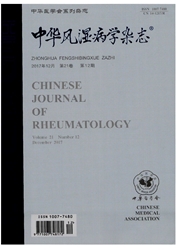

 中文摘要:
中文摘要:
目的筛查PM患者骨骼肌组织中差异表达基因。 方法2015年1月至4月获取于中日友好医院风湿免疫科的5例未经治疗PM患者骨骼肌组织、5例无肌肉病变的创伤患者的对照骨骼肌组织样本,提取组织总RNA,采用基因芯片进行基因表达谱分析。差异表达基因进行基因本体论分析和信号通路分析。采用实时定量PCR方法对芯片筛查的差异基因进行验证。组间比较用t检验,芯片数据分析中的多重比较采用Benjamini-Hochberg法校正。 结果基因芯片共筛选出1 905个差异表达基因,其中787个为上调基因,1 118个为下调基因(差异倍数〉2,P〈0.05)。选择其中3个上调基因和3个下调基因进行实时定量PCR验证,结果证实其表达趋势与基因芯片检测结果一致。基因本体论分析和信号通路分析结果显示这些差异基因主要涉及感染、细胞毒作用等生物学过程,且与其他自身免疫病有部分共同的信号通路失调。 结论PM患者骨骼肌组织与健康人相比存在基因表达差异,PM肌肉病变的发生可能是多基因参与、多基因调控导致。
 英文摘要:
英文摘要:
Objective To profile the differentially expressed genes in the muscle of polymyositis (PM) patients. Methods A mRNA microarray analysis was performed to profile mRNAs from 5 treatment-naive PM patients and 5 healthy controls. Gene Ontology and KEGG pathway analyses were applied to delineate the functional roles of the differentially expressed mRNAs. Quantitative real-time PCR analysis was conducted to validate the microarray data. The Student's t-test was used to analyze the statistical significance of the microarray results, and Benjamini-Hochberg FDR was used for multiple-test correction. Results Microarray analysis revealed that a total of 1 905 mRNAs (787 up-regulated and 1 118 down-regulated) were significantly differentially expressed in PM patients compared with the healthy controls (fold change〉2, P〈0.05). Six mRNAs were selected to analyze by quantitative RT-PCR to validate their expression levels and the results were consistent with that of the microarray analysis, and thus provide reliable validation for the microarray results. Gene ontology and KEGG pathway analysis for the differentially expressed mRNAs revealed that these genes were mainly involved in the biological process of infection and cytotoxic effect. In addition, there were some common signaling pathways that shared by PM and other autoimmune diseases. Conclusion There are differences in gene expressions between PM patients and healthy controls. The muscle damage in PM patients may be due to multi gene involvement and multi gene regulation.
 同期刊论文项目
同期刊论文项目
 同项目期刊论文
同项目期刊论文
 期刊信息
期刊信息
